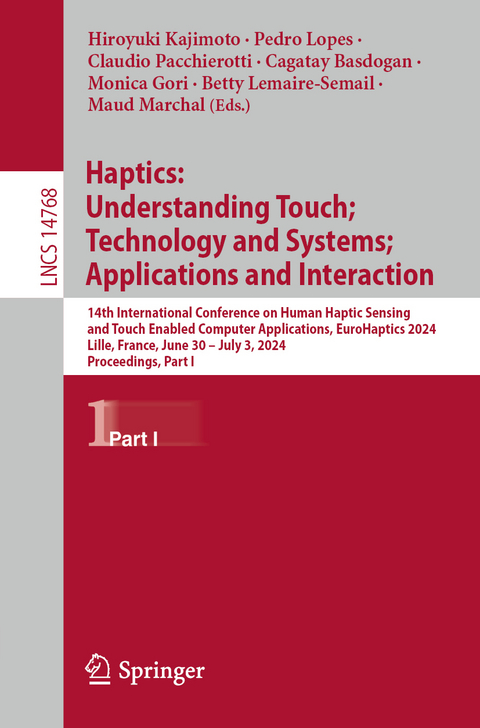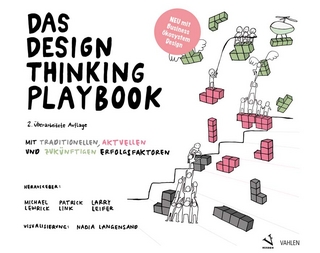
Haptics: Understanding Touch; Technology and Systems; Applications and Interaction
Springer International Publishing (Verlag)
978-3-031-70057-6 (ISBN)
The two-volume set LNCS 14768 + 14769 constitutes the refereed proceedings of the 14th International Conference on Human Haptic Sensing and Touch Enabled Computer Applications, EuroHaptics 2024, held in Lille, France, during June 30 - July 3, 2024.
The 81 full papers presented were carefully reviewed and selected from 142 submissions. They were organized in topical sections as follows: understanding touch; technology and systems; applications and interaction.
.- Understanding Touch.
.- Human Identification Performance of Vibrotactile Stimuli Applied on the Torso along Azimuth or Elevation.
.- Utilizing Absence of Pacinian Corpuscles in the Forehead for Amplitude-Modulated Tactile Presentation.
.- Optimizing Haptic Feedback in Virtual Reality: The Role of Vibration and Tangential Forces in Enhancing Grasp Response and Weight Perception.
.- Audiovisual-Haptic Simultaneity Perception Across the Body for Multisensory Applications.
.- Apparent Thermal Motion on the Forearm.
.- Surface Tactile Presentation to the Palm Using an Aerial Ultrasound Tactile Display.
.- Humans terminate their haptic explorations according to an interplay of task demands and motor effort.
.- The TIP Benchmark: A Tactile Image-Based Psychophysics-Inspired Benchmark for Artificial Tactile Sensors.
.- Towards Intensifying Perceived Pressure in Midair Haptics: Comparing Perceived Pressure Intensity and Skin Displacement between LM and AM Stimuli.
.- Virtual Hand Illusion Induced by Suction Pressure Stimulation to the Face.
.- Task-Adapted Single-Finger Explorations of Complex Objects.
.- Exploring Frequency Modulation in Decoding Edge Perception Through Touch.
.- The role of implicit prior information in haptic perception of softness.
.- Discovering the Causal Structure of Haptic Material Perception.
.- The visual and haptic contributions to hand and foot representation.
.- How Visualizing Touch Can Transform Perceptions of Intensity, Realism, and Emotion?.
.- Technology and Systems.
.- Asymmetric Hit-stop for Multi-user Virtual Reality Applications: Reducing Discomfort with the Movement of Others by Making Hit-stop Invisible.
.- Design of Haptic Rendering Techniques for Navigating with a Multi-Actuator Vibrotactile Handle.
.- Evaluating tactile interactions with fine textures obtained with femtosecond laser surface texturing.
.- Tactile Clip: A Wearable Device for Inducing Softness Illusion through Skin Deformation.
.- SENS3: Multisensory Database of Finger-Surface Interactions and Corresponding Sensations.
.- Variable Curvature and Spherically Arranged Ultrasound Transducers for Depth-Adjustable Focused Ultrasound.
.- The HapticSpider: a 7-DoF Wearable Device for Cutaneous Interaction with the Palm.
.- Vibrotactile cues with net lateral forces resulting from a travelling wave.
.- Enhancing the Perceived Pseudo-Torque Sensation based on the Distance between Actuators Elicited by Asymmetric Vibrations.
.- Presentation of Slip Sensation Using Suction Pressure and Electrotactile Stimulation.
.- Applications and Interaction.
.- Blindfolded operation as a method of haptic feedback design for mobile machinery.
.- Effects of Rendering Discrete Force Feedback on the Wrist during Virtual Exploration.
.- Viscous damping displayed by surface haptics improves touchscreen interactions.
.- Latency Compensation in Ultrasound Tactile Presentation by Linear Prediction of Hand Posture.
.- Pseudo-Frequency Modulation: A New Rendering Technique for Virtual Textures.
.- Do Vibrotactile Patterns on both Hands Improve Guided Navigation with a Walker?.
.- Data-driven Haptic Modeling of Inhomogeneous Viscoelastic Deformable Objects.
.- Perception of paired vibrotactile stimulus on the upper limb: implications for the design of wearable technology.
.- MoveTouch: Robotic Motion Capturing System with Wearable Tactile Display to Achieve Safe HRI.
.- Evaluation of HaptiComm-S for Replicating Tactile ASL Numbers: A Comparative Analysis of Direct and Mediated Modalities.
.- Memorable Vibration Pattern Design based on Writing Pattern.
.- Estimating Contact Force Rate Using Skin Deformation Cues.
.- Move or Be Moved: The Design of a Haptic-Tangible Manipulative for Paired Digital Education Interactives.
.- High-Fidelity Haptic Rendering through Implicit Neural Force Representation.
.- "It's Like Being on Stage": Staging an Improvisational Haptic-Installed Contemporary Dance Performance.
| Erscheinungsdatum | 05.11.2024 |
|---|---|
| Reihe/Serie | Lecture Notes in Computer Science |
| Zusatzinfo | XXVIII, 522 p. 264 illus., 235 illus. in color. |
| Verlagsort | Cham |
| Sprache | englisch |
| Maße | 155 x 235 mm |
| Themenwelt | Mathematik / Informatik ► Informatik ► Betriebssysteme / Server |
| Informatik ► Software Entwicklung ► User Interfaces (HCI) | |
| Schlagworte | haptic communication • Haptic Devices and Rendering • Haptic Illusions and Perception • Haptic Interfaces • Human-Computer interaction • medical simulation • medicine and rehabilitation • Mid-Air and Ultrasonic Haptics • mobile computing • Mobile Devices • multi-modal interaction • Surface Haptics • Tactile/Force Feedback • Tactile/Force Sensors • Telecommunication networks • Teleoperation • User Interfaces • Virtual/Augmented Reality (VR) • Virtual Reality • wireless telecommunication systems |
| ISBN-10 | 3-031-70057-0 / 3031700570 |
| ISBN-13 | 978-3-031-70057-6 / 9783031700576 |
| Zustand | Neuware |
| Informationen gemäß Produktsicherheitsverordnung (GPSR) | |
| Haben Sie eine Frage zum Produkt? |
aus dem Bereich


